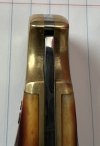Hello all - I recently purchased a Buck 110 (made in 2023) through the authorized Buck store on Amazon and noticed that on the scales, the transitions right before the bolsters are not completely flat. There is a downward slope in the wood about a quarter inch before the bolsters as if it was sanded/buffed so that the surface of the wood would be flush with the surface of the bolsters. Out of curiosity, I ordered another 110 and found the same thing. This is strictly cosmetic and I can only assume that at this price point for a high production knife, the fit and finish is going to vary.
My original expectation was that the scales would be completely flat from end to end, with no signs of a buffed-down transition. I guess one could get lucky and find an example where this "issue" does not occur, but it seems like this part of the variability I mentioned above.
This is mainly a matter of curiosity to help temper my expectations, so I'd be interested in knowing if you are seeing this on your 110s.
My original expectation was that the scales would be completely flat from end to end, with no signs of a buffed-down transition. I guess one could get lucky and find an example where this "issue" does not occur, but it seems like this part of the variability I mentioned above.
This is mainly a matter of curiosity to help temper my expectations, so I'd be interested in knowing if you are seeing this on your 110s.
Last edited:


